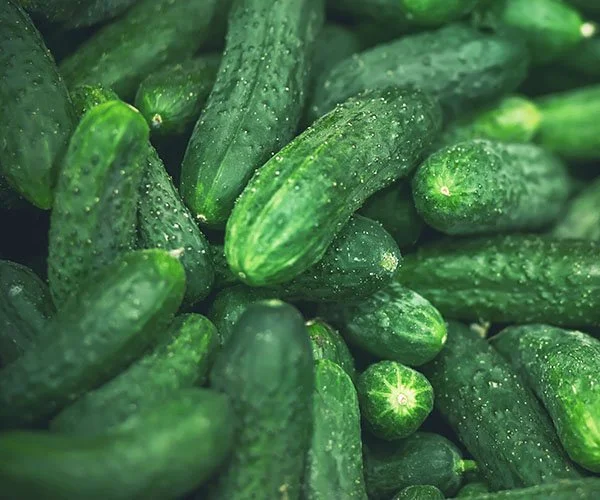Cucumbers
Not many vegetables can claim they’re responsible for foreshadowing a revolution in agriculture. But the cucumber can.
The tubular green veggie better known for its place in salad bowls and pickle jars began its trip into history when the Roman Emperor Tiberius (42 BC – 37 AD) took a liking to it – a strong liking.
Tiberius liked it so much he instructed his gardeners to make sure he was served cucumbers every day of the year, no matter what the season, according to Pliny the Elder, who described the developments in his opus, Natural History.
The book, credited now as the first true encyclopedia ever compiled, says Tiberius didn’t care if the cucumber was a summer vegetable. He wanted it as much in cold weather as in warm.
So the Imperial gardeners came up with a plan. They grew the cucumbers in portable beds they could roll around on wheels, moving the treasured plants to warm, sunny spots around the palace and avoiding the cold, cloudy locations. During the winter, when it was impossible to find natural warmth, they shielded the moveable beds under sheets of mica, a rigid transparent stone that kept the cold out but let the light in.
Voila. They had a greenhouse, a portable one at that, which they called the specularium. Tiberius had his cucumbers, the gardeners kept their jobs – and heads -- and civilization had a way to grow food in the winter.
Today we eat the same vegetable Tiberius did, though ours is probably bigger and a little sweeter. And we eat it year-round too, thanks to modern greenhouses and high tunnels.
Food historians believe the cucumber has been cultivated for at least 3,000 years, originating in India, where a great many varieties have been observed. It was probably introduced to Europe by the Greeks or Romans through trade.
Records of cucumber cultivation appear in France in the 9th century, England in the 14th century, and in North America by the mid-16th century.
Tiberius wasn’t the only world leader to hunger for them. Charlemagne had cucumbers grown in his gardens in the 8th and 9th centuries. Although they were introduced into England in the early 14th century, they were lost and not reintroduced until approximately 250 years later.
The cucumber continued its own conquest of the world when the Spaniards, through the Italian Christopher Columbus, brought cucumbers to Haiti. In 1494. In 1535 Jacques Cartier, a French explorer, found "very great cucumbers" grown on the site of what is now Montreal.
Throughout the 16th century, European trappers, traders, bison hunters, and explorers bartered for the products of American Indian agriculture, according to Wikipedia. The tribes of the Great Plains and the Rocky Mountains learned from the Spanish how to grow European crops. The farmers on the Great Plains included the Mandan and Abenaki. They obtained cucumbers and watermelons from the Spanish, and added them to the crops they were already growing, including several varieties of corn, beans, pumpkins, squash, and gourd plants.[29] The Iroquois were also growing them when the first Europeans visited them.
The most commonly available type of cucumber today is the greenhouse or English cucumber, and a shorter, stockier market cucumber. Other types of cucumber include:
Armenian, or snake cucumbers: These are long and twisted with thin, dark green skin and pale furrows. People often use them for pickling.
Japanese cucumbers: These are dark green and narrow. The skin is thin with small bumps on it. People can eat them whole.
Kirby and gherkin cucumbers: People often use these for dill pickles. They are crispy, with thin skin and small seeds.
Lemon cucumber: These are around the size of a lemon, with pale skin. The taste is sweet and delicate.
Persian cucumbers: Shorter and fatter than the greenhouse cucumber, these are crunchy to eat.
Cucumbers are tasty but not particularly nutritious. A raw unpeeled cucumber is 95 percent water, 4 percent carbohydrates, and 1 percent protein.. It has a low content of micronutrients: it is notable only for vitamin K, at 16 percent of the Daily Value.
But people nevertheless like it. Tiberius’ gardeners hit on the brilliant idea that the cucumber could be forced to grow into all sorts of shapes, including that ‘of man or beast.’ All they had to do was wait until the cucumber shed its blossom and then enclose it in variously shaped wicker sheaths. The growing cucumber adapted itself to the form.
They also experimented with its flavor. They believed, for instance, that if the seeds were soaked in milk and honey before they were sown, the ripe cucumbers would be infinitely more tender and sweeter.
Here’s a final, modern tip. If at the end of the summer someone offers you a few overgrown cucumbers full of seeds, don’t despair. They can still be turned into a delicious dish. Peel the cucumbers, cut them in half lengthwise. Scoop out all the seeds, leaving a big trench. Heap ground meat, prepared as you would for meatloaf, into one of the cavities. Put the two halves back together and tie with string. Brown the cucumber in a pan with olive oil, salt and pepper, and cook it gently until the meat is done. Add some liquid if necessary. To serve, untie the string and slice. You can also stir fry pieces of the peeled and de-seeded cucumber. Cook until nearly translucent.

